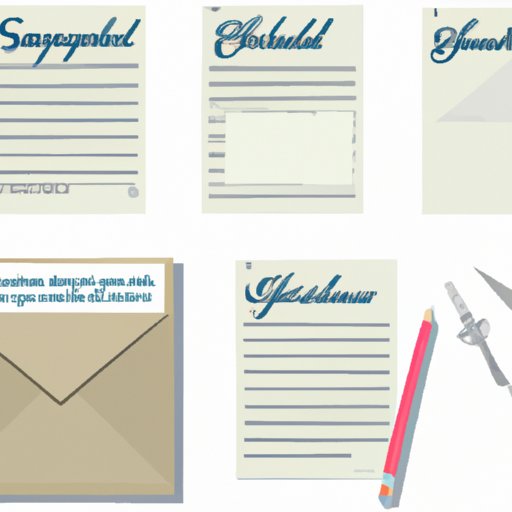Introduction
Although it may seem like a simple task, writing a letter envelope correctly can make or break the delivery of your message. Not only is it important to address it accurately, but different types of addresses require different formatting. In this article, we will take you through a step-by-step guide for writing a letter envelope. Additionally, we will provide some tips and tricks to make your envelopes stand out and common mistakes to avoid.
Step-by-step guide for writing a letter envelope
The first step for writing a letter envelope is to gather the necessary materials. Ensure you have the envelope, writing paper, a pen or pencil, and the address of the recipient. Once you have these, follow the steps below:
- Write your return address at the top left corner of the envelope. Do not forget to include your name.
- Write the recipient’s address in the center of the envelope. Make sure to include the name, house/office number, street name, city/town, state/province, and postal code.
- Place the stamp at the top right corner of the envelope, ensuring that it has enough postage for the destination.
- If you are sending multiple pages or documents, indicate this by writing “Enclosed” or “Encl.” in the bottom left corner of the envelope. Alternatively, you may write “Attachment(s)” if applicable.
- Lick or moisten the adhesive on the envelope flap and seal it shut.
- Double-check the address, postage, and seal to ensure that it is correct and secure.
Addressing and formatting an envelope
Formatting an envelope can differ depending on the type of address used. Below are the most common types of addresses and how to format them:
Domestic Addresses
When addressing a domestic letter envelope, adhere to the following formatting:
[Recipient name]
[House/building number and street name]
[City/town], [State/province] [Postal code]
[Country (If necessary)]
International Addresses
International addresses have different formatting, depending on the country of the recipient. Below is the usual order of the address for most countries:
[Recipient name]
[House/building number and street name]
[Postal code], [City/town]
[Province/region/state (if applicable)]
[Country]
PO Box Addresses
If the recipient’s address is a post office box, the formatting can differ slightly; use these steps:
[Recipient’s name]
[Post Office Box number]
[City/town], [State/province] [Postal code]
[Country (If necessary)]
Delivery to a Business Address
If sending to a business within a building with multiple companies, add this additional line below the address of the recipient:
c/o [The name of the company]
[Recipient name]
[House/building number and street name]
[City/town], [State/province] [Postal code]
[Country (If necessary)]
Tips for writing a letter envelope
Aside from addressing and formatting, there are some tips to follow to ensure your envelope is effective:
Use legible handwriting
Ensure that your handwriting is legible and easy to read to avoid confusion or loss of mail.
Use the correct postage
Ensure you have adequate postage for your mail to prevent it from being returned to you.
Avoid abbreviations
Abbreviations or slang are not recommended when writing a letter envelope, as they can cause confusion or delay delivery.
Avoid handwritten mistakes or corrections
When making errors or needing to make corrections, use a new envelope to maintain the professionalism and legibility of your letter envelope.
Tricks to make your envelopes stand out
If you want to add a personal touch or make your envelopes stand out, consider the following:
Use decorative lettering
You can add a personal touch to your envelope by using decorative lettering styles to make it stand out.
Use colorful ink or paper
Another way to add a unique touch is by using vibrant or brightly colored ink or paper to make your envelope more visually appealing.
Include a personalized stamp
You can order personalized stamps to create a professional, unique look.
Common envelope writing mistakes and how to avoid them
Some common mistakes to avoid when writing a letter envelope include:
Incorrect or Incomplete Address
You should ensure your recipient’s address is complete and accurate to prevent any delays or confusion in delivery.
Insufficient Postage
Always ensure you have the correct amount of postage for your mail. Not having enough postage can cause your mail to be returned, delayed, or canceled entirely.
Inconsistent Lettering or Handwriting
Inconsistent or illegible lettering can cause confusion and may lead to delayed or lost mail. Ensure your handwriting is clear and legible.
Writing letter envelopes – Frequently Asked Questions
What is the correct way to write an address for an envelope?
Starting at the top left corner, write your return address. In the center of the envelope, write the recipient’s address. Include all necessary components such as name, house/office number, street name, city/town, state/province, and postal code or country if necessary.
How do I write an envelope to a business?
If mailing a letter to a business, add “c/o” before the company name on the second line of the address. The first line should contain the name of the recipient or the department within the company that should receive it.
Can I leave my return address off of a letter?
No. The return address is crucial in ensuring that any undeliverable mail is returned to you, and it is also standard practice to include a return address.
Can I write on a different color ink?
Yes, you can choose a different color ink or paper, but make sure that the address remains clear and legible.
How do I address an envelope to a couple?
When addressing a letter to a couple, write the names of the recipients on separate lines with “and” between them.
Conclusion
Properly addressed and formatted mail is important in ensuring that your message is delivered to the intended recipient. By following the steps and tips outlined above, you can create an effective letter envelope to deliver your message successfully.
